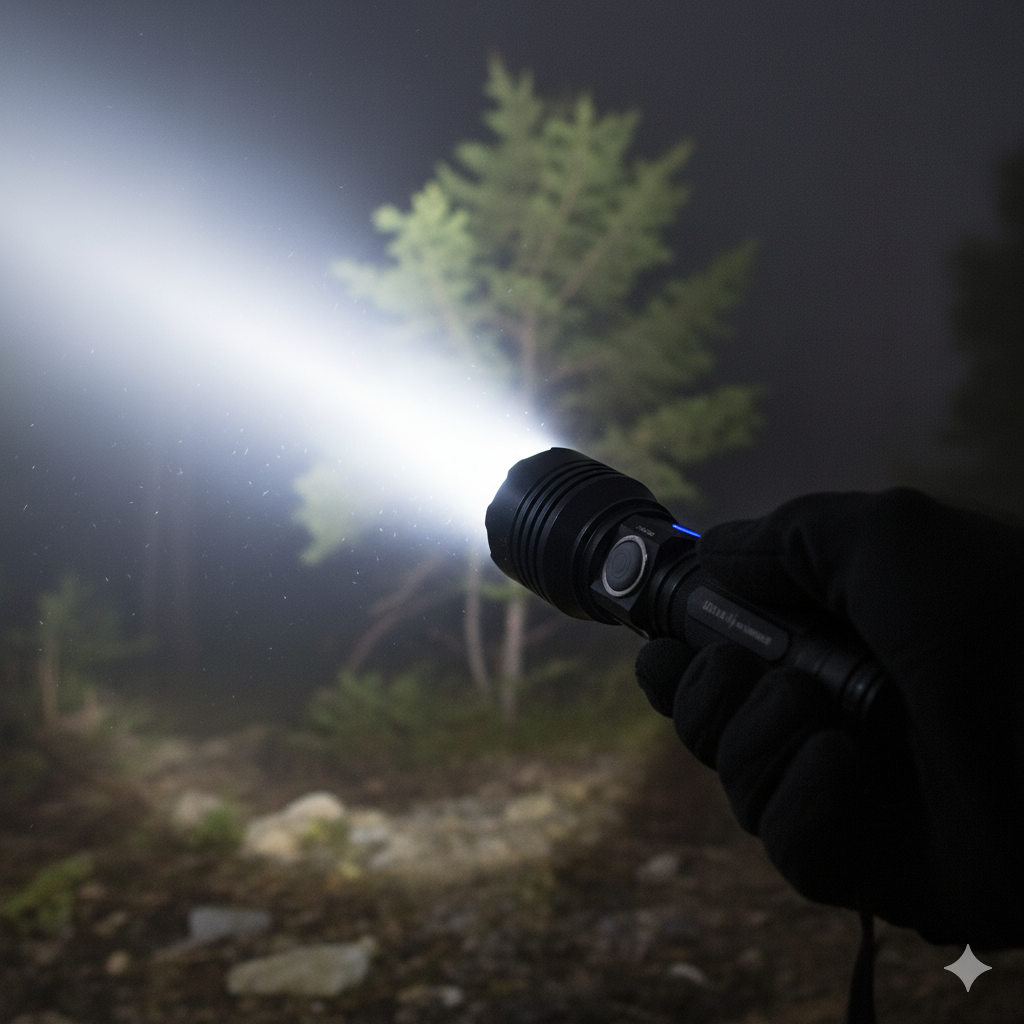Flashlight Beam Distance Explained | Testing Methods & Real-Life Performance Guide 2025
Posted by Raymond on 12th Nov 2025
When shopping for a flashlight, you’ve probably seen specifications like “beam distance: 300 meters” or “throw distance: 500m.”
But what does beam distance really mean — and how accurate are those numbers?
In this guide, we’ll break down the science behind flashlight beam distance, explain how it’s tested under ANSI FL1 standards, and compare real-life performance between top models.

1. What Is Flashlight Beam Distance?
Beam distance is defined as the maximum range at which a flashlight can emit 0.25 lux of light — roughly equivalent to the brightness of a full moon on a clear night.
This means that if a flashlight is rated for 300 meters, it should illuminate an object 300 meters away just enough to make it visible.
Beam distance depends on:
-
Lumen output (brightness)
-
Beam focus or throw
-
Reflector and lens design
-
LED type and quality
2. Understanding the ANSI FL1 Standard
To standardize flashlight performance testing, the ANSI/NEMA FL1 standard was introduced.
Under this method:
-
Flashlights are tested in controlled conditions.
-
Beam distance is measured until light output drops to 0.25 lux.
-
Results are consistent across different manufacturers.
You can read more about the official guidelines on the National Electrical Manufacturers Association (NEMA) website.
3. Throw vs. Flood: Two Types of Beam Patterns
| Beam Type | Description | Best For |
|---|---|---|
| Throw (Spotlight) | Concentrated beam, long distance (up to 1000m+) | Search, rescue, tactical use |
| Flood (Wide Beam) | Broad, evenly lit area, shorter range | Camping, close-up work |
| Hybrid Beam | Mix of both styles, adjustable focus | General-purpose use |
For example, a TANK007 KC70 Plus flashlight features a rotating zoom head, allowing users to switch between flood and throw modes — ideal for both hiking and professional use.
4. Factors Affecting Real-Life Beam Distance
While manufacturers test in ideal lab conditions, real-world use can vary greatly.
Here are some factors that impact beam distance performance outdoors:
| Factor | Effect on Beam Distance |
|---|---|
| Weather | Fog, rain, or dust scatter light, reducing visibility |
| Ambient Light | City or moonlight reduces perceived distance |
| Battery Level | Low voltage lowers brightness output |
| Reflective Surfaces | Light-colored or shiny surfaces extend visible distance |
| Temperature | High heat can lower LED efficiency |
Example:
A flashlight rated for 400 meters in lab tests may only illuminate effectively up to 250–300 meters in heavy fog.
5. Real-Life Comparison: Beam Distance by Model
| Model | Max Lumens | Beam Distance (ANSI FL1) | Real-Life Effective Range | Best For |
|---|---|---|---|---|
| TANK007 KC70 Plus | 2000 lm | 500 m | 350 m | Outdoor, tactical |
| Olight Warrior X4 | 2200 lm | 600 m | 400 m | Search, police |
| SureFire Fury DFT | 1500 lm | 315 m | 250 m | Everyday use |
| Fenix PD36R | 1600 lm | 283 m | 230 m | Camping, hiking |
Note: Manufacturer data from respective product pages (e.g., Olight Official, Fenix Lighting).
6. How to Test Beam Distance Yourself
You can perform a simplified test at home:
-
Find an open area (e.g., park or field) at night.
-
Place a reflective object (e.g., road sign) 100m–300m away.
-
Use a lux meter app or camera light sensor to measure brightness drop-off.
-
Compare readings from different flashlights.
This helps you understand how your flashlight performs under real-world conditions — not just marketing claims.
7. Choosing the Right Beam Distance for Your Needs
| Usage Scenario | Recommended Beam Distance | Flashlight Type |
|---|---|---|
| Camping / Hiking | 150–300m | Rechargeable flood or hybrid |
| Search & Rescue | 500–1000m | Long-throw tactical |
| Home & Emergency | 100–200m | Compact everyday carry |
| Law Enforcement | 300–600m | Tactical or dual-beam models |
If you need long-range visibility with flexible focus, consider a zoomable flashlight such as the TANK007 KC70 Plus.
8. Expert Tip: Don’t Rely Only on Distance
Many buyers assume that a longer beam distance automatically means a better flashlight — that’s not always true.
Beam quality, brightness consistency, and runtime are just as important.
Look for balanced performance rather than chasing maximum distance specs.
Conclusion
Understanding flashlight beam distance is crucial when choosing a model that matches your needs.
By learning how ANSI FL1 standards work and recognizing the real-world limits of beam distance, you can make smarter, more confident purchases.
Whether you need a flood beam for camping or a long-throw beam for search operations, matching the beam distance to your environment ensures safety, visibility, and efficiency.

